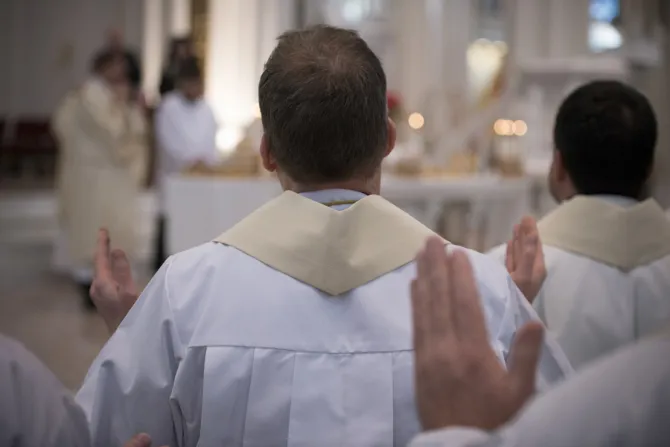Philadelphia, Pa., Jun 20, 2016 / 23:04 pm
Bishop Francis Patrick Kenrick, the third bishop of Philadelphia, started St. Charles Borromeo seminary out of his home on Fifth Street in the center of the city in 1832. There were just five students.
Forty years and four moves later, the seminary settled at its current location – the Overbrook campus in Wynnewood, Pennsylvania, in 1870. With a beautiful 75 acres in the peaceful neighborhood, the school has become a pillar of the community over the past 146 years.
Now, the seminary must undergo another move.
This month, officials announced that the school was abandoning a previous plan for consolidation on the current campus, and is looking to move to a partner Catholic college or university in the archdiocese.
Bishop Timothy Senior, the rector of St. Charles, was brought in during 2012 with the difficult mandate of deciding what to do with a seminary losing money to aging and unused buildings.
"The excess capacity on the campus in Overbrook was really a longstanding challenge, it wasn't a new problem," Bishop Senior told CNA.
He said while enrollment numbers have ebbed and flowed since his own education at the seminary in the 1980s, they have always ranged from about 140-170, far below the peak number of students and future priests in times like the 1950s.
"Meanwhile the program is encumbered with the excess infrastructure, built for another age, for a day when seminaries were much larger," he said.
The original plan was to consolidate and move students into half of the 650,000 total square feet of buildings on campus. The undergraduate seminary students on the so-called "lower side" would move to join the graduate theologian students on the "upper side," and the lower side would be marketed and sold.
The school was already struggling to raise the necessary millions of dollars to keep up with annual operating costs, and had steadily chipped away at its endowment fund over the years, which it attempted to replace by selling some of its most valuable art and historic books.
Still, the consolidation would have cost the seminary $50 million at a conservative estimate, and saved the school just $1 million on operating costs, a very small portion of the actual costs, Bishop Senior said.
After a feasibility study and talks with donors, alumni, and the Catholic faithful of the diocese, Bishop Senior said while there was still clear support for the seminary, there was not support for spending $50 million on renovating the old buildings.
St. Charles Borromeo seminary. Credit: CatholicPhilly.com
"Then the question became, would you support a plan where there would be a campaign for the endowment of the seminary because the seminary has relocated and sold the entire campus and built new facilities elsewhere? There was a lot of support for that, from all sectors - from alumni who were interviewed, from major donors, the lay faithful and partner bishops," Bishop Senior said.
The decision was not an easy or unsentimental one. While it's been in the works for about a year, the decision to move instead of consolidate has been "painful," said Bishop Senior, who himself is an alum of St. Charles.
"I don't want to minimize the attachment to the campus," he said.
"First of all it's a beautiful campus, secondly it's a historic place. For priests and lay people and permanent deacons and religious who have gone to the seminary there and studied theology and have discerned their vocations to ministry, it's a very sacred place."
(Story continues below)
But it's also a place that's deteriorating, with a lot of deferred maintenance and excess space that is "encumbering the mission" of the seminary, Bishop Senior said.
"And that's where I start saying, the seminary is not a museum."
The next step is for the seminary board and faculty to find a suitable partner college, with some available land where St. Charles could build whatever facilities they would need that they would not share with their partner school.
Bishop Senior said so far, the conversations with potential partner schools out of the archdiocese's 11 Catholic colleges and universities have been "very hypothetical." The process of finding a partner, building additional facilities and moving will take another two or three years.
"We have to have a commitment to the mission of the seminary and a solid commitment to Catholic identity in order for it to be a suitable partner," he said.
"And it also has to be a win-win, good for us and good for that institution."
But while the move has been a difficult conclusion to come to, Bishop Senior said the program at the seminary is strong. Enrollment jumped from 128 in 2013 to 146 at the end of this school year, and projected numbers for next year are up to 168.
Partnering with a college or university is also not uncommon – approximately one-third of seminaries in the United States follow this model, Bishop Senior said.
"We're going to have the same sense of zeal and mission that those who built Overbrook campus and established the seminary way back in 1800s had," he said.
"They weren't interested in preserving institutions as they had been known, but they were interested in responding to the needs of the Church at that time."
"Even as we treasure our past and recall the tradition, the most important thing is the formation of leaders, priests and other leaders who have that spirit of evangelization and missionary discipleship."
Update 6/22, 1:32 p.m.: A previous version of this story incorrectly stated that the current operating costs of St. Charles seminary are $3.4 million. Rather, $3.4 million is the amount currently raised to cover much higher operating costs. It has since been corrected.



